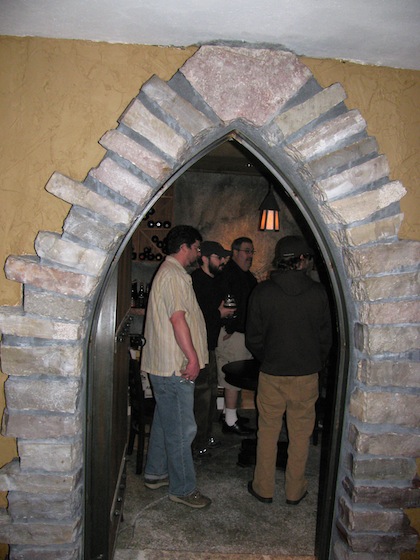The Rolls Royce of Beer Cellars
Seattle, of course, is one of America’s premiere beer towns, so it’s no surprise that a most amazing private beer cellar can be found there, down an unassuming tree-lined neighborhood street. Matt VandenBerghe founded one of the country’s best beer stores—Bottleworks—and more recently Brouwer’s Café, a similarly amazing beer bar with an emphasis on Belgian cuisine and beer.
VandenBerghe converted the root cellar in his basement into a dedicated beer (and wine) cellar. Root cellars used to be in nearly every home in the days before refrigeration, and were used to store vegetables and other food supplies to keep them from spoiling. Normally, they were dug into the earth to keep a low temperature and steady humidity year round.
VandenBerghe found that under the floorboards was just cold dirt, ideal for starting from scratch. He dug down a little farther, back-filled about 8 inches of gravel, and poured concrete. The walls he lined with stone, installed shelves and put copper on the top of each one, both in an effort to keep the room naturally cool and also to avoid using any artificial or electric methods to control the temperature. Water trickles down one wall to provide natural humidity and keep the cellar from becoming overly dry. You feel as if you’ve stepped back in time, like you’re inside a dark, ancient cave.

Matt VandenBerghe of Bottleworks refurbished an old root cellar into a seemingly ancient beer vault.
A small fountain sits atop a table in the center of the room, purely for aesthetic reasons, and the overall feeling inside the cellar is a calming, Zen like spirituality. It’s a cave of wonders, especially for the beer aficionado, and ultimately feels both modern and ancient at the same time. This feeling is further enhanced by a handcrafted medieval door, a thick wooden piece that tapers to a point at the top, surrounded by stone masonry when closed. It’s a room you want to spend time in … and maybe drink a few beers.
Some of VandenBerghe’s most prized beers include Hair of the Dog Adam, Batch 1, Trappistes Rochefort 10, along with many other Belgian quadrupels, tripels, and lambics.
You’ve Built A Beer Cellar, Now What?
So now you have a dedicated space to age some beer, what should you fill your cellar with? While hardly an exact science, there are a few rules of thumb that should help you avoid having a room full of the beer equivalent of the billionaire’s vinegar. Generally speaking, it’s strong beer that will stand the test of time best. With few exceptions, nothing less than 8 percent ABV is the minimum a beer should be in order to be a solid candidate for aging. Anything below 10 percent ABV should only be aged for a few years, depending on style, and rarely more than five years.
Once you get over the ten percent threshold, however, it’s anybody’s guess and it’s largely on a beer-by-beer basis. The stronger the beer, the better the chances it will hold up for a longer period of time.
Ales generally age far better than lagers, except for the strongest ones. Bottle-conditioned beers, which still contain live yeast, are also good candidates since they continue to condition the beer in the bottle and tend to age rather gracefully as a result.
Ironically, hops were first added to beer over a thousand years ago as a preservative, allowing the beer to last longer, but hoppy beers are generally not good candidates to age in a beer cellar. Most hoppy beers, even double and triple IPAs, are best when the hops taste bright and fresh, that is when the beer is as young as possible. Over time, hop aromas and flavors fade and tend to break down and dissipate, losing much of the fresh qualities that make them so desirable.
Sour beers are something of an exception to the strength rule of thumb. Even lower alcohol lambics, for example, will age well for many years, as will Flemish red ales.











